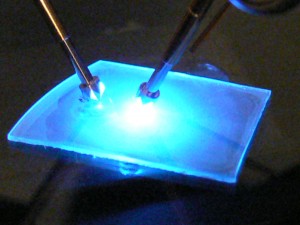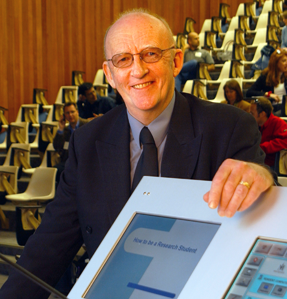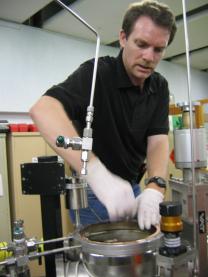
The 2014 Nobel Prize in Physics was awarded jointly to Isamu Akasaki, Hiroshi Amano and Shuji Nakamura “for the invention of efficient blue light-emitting diodes which has enabled bright and energy-saving white light sources”. The advent of the blue Light Emitting Diode (LED) will revolutionise lighting in 21st century with a much higher efficiency than the now almost extinct incandescent bulb and the more commonly used fluorescent tube.
The early work leading to the invention of the Blue LED was carried out at Macquarie University in the Semiconductor Science and Technology Laboratories (SSTL). Professor Trevor Tansley – who passed away in 2011 – was a pioneer in the field on Nitride semiconductors, along with Dr. Cathy Foley, now the Chief, CSIRO Materials Science and Engineering and Dr. Scott Butcher. This excerpt taken from a book on Macquarie University’s research highlights over the past 50 years tells the story:
Dr Butcher was representing a research team at Macquarie led by Professor Trevor Tansley, who was internationally recognised for his work on semiconductors and materials physics. As proceedings got underway, Dr Butcher realised it was a significant day for his team.
“The workshop was held at the Nagoya convention centre and outside flew the flags of the nations represented, including Australia,” he recalls. “The workshop organisers read out the numbers of delegates from each country and when they got to Australia, they said there was one delegate.”
“There was an audible disturbance in the audience. No other country received that reaction. It was well known that Macquarie had an important pioneering group in nitrides research. We were far away geographically, but everyone wanted to speak to us.”
In 1995, the potential for nitride semiconductors to be used in light emitting diodes (LEDs) that produced very bright blue or green light was starting to receive wider recognition. The technology stood to transform optoelectronics with applications in the defence, aerospace, energy and entertainment sectors, from the manufacture of Blu-ray disc players to satellites in orbit.
For Professor Tansley, however, its potential was not new. In 1986, he published a defining paper in the journal of Applied Physics, co-authored with Dr Catherine Foley, who also worked in the School of Mathematics and Physics at Macquarie. Entitled, ‘Optical band gap in indium nitride‘, the paper went on to receive more than 600 citations and established Professor Tansley as a visionary in his field.
“Trevor had great foresight. He could see the potential for research in a given area,” says Dr Butcher. “When Trevor began his work in this area, there were only a few other groups in the world working on nitride semiconductors as an obscure material system.
Now, it is a multi-billion dollar industry, with thousands of employees and many advanced products such as LEDs for room lighting and laser diodes that have enabled Blu-ray and PlayStation devices.”
After the Nagoya conference, interest in nitride semiconductors grew dramatically with companies in the US, Europe and Japan investing millions of dollars to develop the technology. Again, Professor Tansley showed foresight by specialising in the growth of nitride semiconductors at low temperatures – an approach that was not an immediate priority for industry, but became more important in the years to follow.
In 2005 the Macquarie research was commercialised through BluGlass Ltd. Dr Butcher was appointed Chief Technology Officer and the company floated on the Australian Stock Exchange in 2006. Another company, MEAglow Ltd, was founded in 2009.
“Science doesn’t happen in a moment. It can take decades to realise the value of some research,” says Dr Butcher. “Trevor’s ‘big idea’ was having the foresight to see that a contribution to the future can be made now – decades in advance.”
A paper by Shuji Nakamura et. al. from 1998 discussing the gain mechanism in GaN based laser diodes draws on the research described in the 1986 paper by Foley and Tansley.
Dr. Scott Butcher, an Honorary Associate of the Department of Physics and Astronomy and founder of of Meaglow Ltd. was asked for comment on Macquarie’s Nitride research in light of the awarding of the Nobel Prize:
“Cathy Foley (a then PhD student) and Trevor Tansley (her supervisor) began work into the same area of research as the 2014 Nobel Prize for Physics almost a decade before the winners of that prize. The excellent work done by Cathy and Trevor attracted other researchers to the potential of these nitride materials.
I remember Trevor telling me that he could never get ARC funding, because the referees always said that nothing would ever come of the nitrides. How wrong could they have been, the results showed otherwise. The nitrides have sprouted an industry worth more than 15 billion dollars. But the Macquarie story is one that shows the benefits of long term research, for it was almost 25 years after Cathy and Trevor did their work, with many others building upon it, that local fruits for their labour began to evolve.
The public company BluGlass in Australia, and my own company Meaglow Ltd. can both trace their roots back to that time way back when, when Cathy and Trevor tried to make an LED out of an obscure material that no one cared about.”
The nitride research at MQ is continuing under the guidance of Dr. James Downes, but with a focus on the nascent technology of spintronics.



